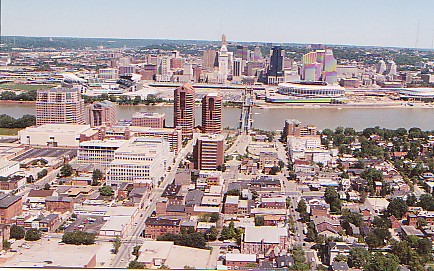
Recent aerial view of the bridge. (LarryStulz photo)
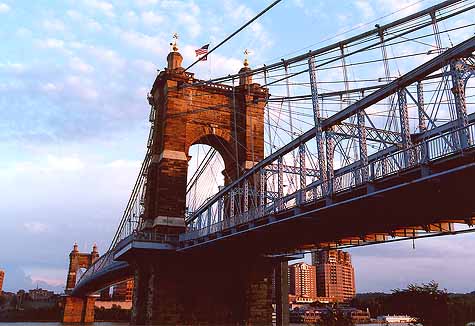
Few American cities can claim a landmark asdistinctiveas Cincinnati's Suspension Bridge. The Covington and Cincinnati Bridge,in 1984 renamed after designer John A. Roebling, and all the whilecalledby locals simply "The Suspension Bridge", has been a symbol of the citysince its completion in December of 1866. Images of the bridge canbeseen todayin all parts of the city hanging in homes, offices, restaurants, bars,waiting rooms, and as backdrops for the local television news. Morethan just a nostalgic decoration, the old bridge remains an importantrivercrossing for thousands of cars and buses each day. The bridge will close in October of 2006 for a year of repairs and repainting, however the bridge is expected to carry vehicular traffic for several more decades.
Cincinnati was the first major city in "The West",or what is today known as the Midwest. Its 1850population of 115,435 ranked sixth in the United States, far aheadof St. Louis (77,860) and Chicago (29,963). Itscross-river neighbors of Covington and Newport were home to 20,000 moreresidents, and as ferry traffic increased, the necessityof a bridgebecame apparent. The 1849 charter issued by the state of Ohiorequiredno piers in the river, a length of 1,400ft., and a deck clearance of112ft. By the time constructionstarted in 1856, a revised charter eased the required length to1,000ft. and height to 100ft. Theensuing period of construction stretched over a decade, interrupted byfinancial shortages and the Civil War, during which the city andunfinishedbridge were under threat of attack.
The bridge opened to pedestriansin December 1866, and the 1,057ft. main span was at that time thelongestin the world, surpassing the Wheeling, WV suspension bridge(1849). Not only was the Cincinnati Suspension Bridge the world's longest, butit was also the first to utilize both vertical suspenders and diagonalstays fanning from either tower. This advance was next seen ontheBrooklyn Bridge (also designed by John Roebling), which surpassed theCincinnati bridge in length and almostevery other statistical category in 1883.
Due to inflation during and after the Civil War, theoriginal iron and oakdeck was built as cheaply as possible. In 1894 tracks were laid acrossthe deck but street cars were limited to a "walking" 1.5mph speedlimit.Therefore in 1896 a complete rebuilding of the bridge deck wasundertaken.While the original deck had been built cheaply, the stone towers wereoverbuiltand capable of carrying a much heavier load. Therefore a secondsetof 10.5" main cables, a wider steel truss deck (a four track deck wasevenbriefly considered, with outside tracks curving around the towers), andan extension of the northern approach were included in this project. Inorder to keep the bridge open and maintain the 100ft. heightrequirement,the old deck was jacked up several feet on its suspenders while workproceededabove, below, and around it. The new deck was built around the old deckfrom the towers towards the center, first hung from the new maincables,and then transferred over to the elaborate four cable arrangement seentoday.The reconstruction significantly altered the appearance of the bridge,but allowed it to remain useful in the 20th century, with a 30 tonweightlimit.

Recent aerial view of the bridge. (LarryStulz photo)
In the 1920's a pair of ramps were constructed fromthenorth end of the Suspension Bridge to Dixie Terminal, an ornate tenflooroffice building and street car terminal located at the southwest cornerof 4th & WalnutSt. The ramps provided Covington trolleys with a grade separated route tothecenter of downtown, and the terminal building was originally intendedto connect, via underground pedestrian passages, with the never-builtFountainSquare Station of the infamous Cincinnatisubway. Since Cincinnati had an unusual two-wire street carsystem(enforced by a city ordinance) versus the standard single overhead wireand track ground arrangement of Covington and nearly everywhere else inthe world, cars had to raise a secondpolewhen the northern end of the bridge was reached before entering thebuilding.After street car service ceased, the ramps were rebuilt for diesel busservice in the late1950's as part of the construction of Ft. Washington Way. These rampswere torn down in summer 1998 asreconstructionof Ft. Washington Way began, and buses stopped using theterminal. Kentucky buses still use the Suspension Bridgeheavily,however they now run a short route through downtown Cincinnati.
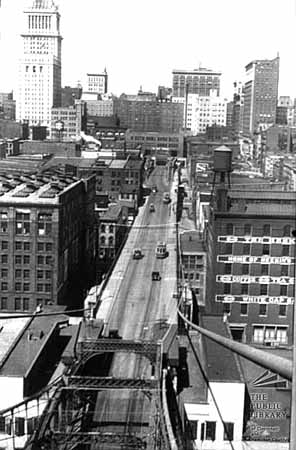
1920's view from the north tower, looking north towards Dixie Terminal.
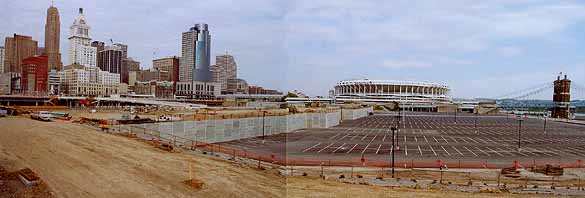
View of central riverfront in October 2000 looking east from Elm St.
The bridge's Cincinnati approach has changed dramatically in the last ten years, with significant new construction still planned. An industrial area and railroad yard up through the mid 1900's, the city was unable to redevelop the riverfront because of the immense cost associated with either raising the entire flood plain with fill dirt or building everything atop multi-deck parking garages. After languishing as a periodically flooded parking lot for several decades, a local sales tax passed in 1996 triggered the complete reconstruction of the area. The last warehouses, railroad tracks, and vestiges of the old industrial riverfront were cleared in 1998 and the area has been the site of constant heavy construction activity since. Since passage of the tax, two new sports stadiums, the National Underground Freedom Center, the Cincinnati Reds Hall of Fame & Museum, one underground parking garage, and the Riverfront Tansit Center have been completed. Still planned are several more underground parking garages, 1,000 or more apartment units, office space, and a large riverfront park to either side of the Suspension Bridge approach.
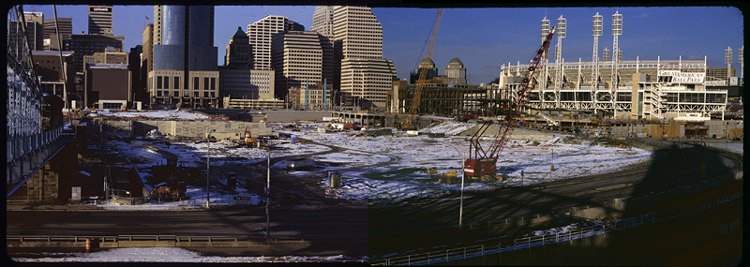
Panoramic view of the former Riverfront Stadium site from the bridge's north tower.
[January 2004 Jake Mecklenborg]
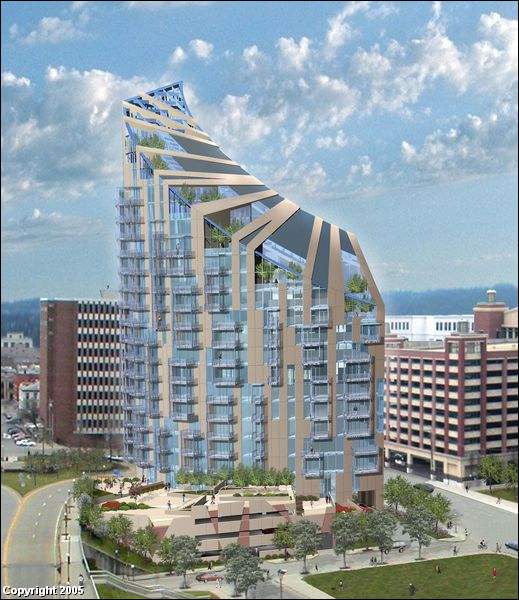
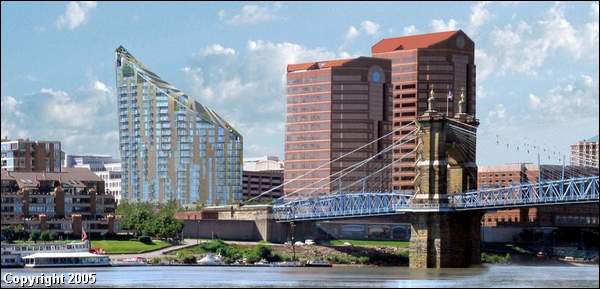
Bridge to close for repairs
By Greg Paeth
Post staff reporter
The state of Kentucky plans to close the historic John A. Roebling Suspension Bridge for a year so it can make extensive repairs and do maintenance on the span.
The 140-year-old, two-lane bridge between Covington and Cincinnati is expected to close in October immediately after the Greater Cincinnati Tall Stacks Festival Oct. 4-8, according to the Kentucky Transportation Cabinet's Department of Highways.
Structural and electrical repairs as well as repainting would be completed over the one-year period, the highway department said.
"There are safety concerns, but there is nothing that is critical at this point in time. But if left unattended, they could become critical," said Tom Schomaker, chief engineer for the cabinet's District 6 in Fort Mitchell, Ky. "If we had critical safety concerns, we would close it right now."
The repairs are estimated to cost $2.83 million, while the paint job may cost $6 million to $8 million, Schomaker said.
He said his agency has talked with officials from the Transit Authority of Northern Kentucky - TANK - about plans to route bus traffic off of the bridge. Although most trucks are already prohibited from using the bridge, TANK buses make hundreds of trips over the span every day.
"That's a lot of weight on the bridge, and it's the repeated effect of those trips that creates fatigue (of the structure)," Schomaker said. "At some point in the future, the bus traffic has to be off the bridge.
"We spent $10 million on structural repairs 10 years ago," said Schomaker, adding that "excessive loading" from heavy vehicles is a primary cause of structural damage to the bridge.
Gina Douthat, director of communications for TANK, said there are more than 700 bus trips across the bridge every weekday.
She said the bus system is planning for the shutdown and may re-route its buses to either the Clay Wade Bailey Bridge, just downriver from the Suspension Bridge, or the Taylor Southgate Bridge in Newport, about a mile upstream.
"It will add some time to each of our trips," said Douthat, who said the transit agency will have to weigh additional costs of the new routes as well as the number of minutes that will be added to routes.
She also pointed out that several hundred bus passengers transfer from one bus to another in the transit center on the ground floor of the parking garage on Scott Boulevard that is just a short distance from the Suspension Bridge.
Douthat said that most of TANK's urban routes come through Covington and then over the Suspension Bridge into Cincinnati. Express routes from more distant suburbs cross the river on the Brent Spence Bridge, according to Bill Alexander, TANK's manager of scheduling.
Douthat said TANK wants to continue using the Suspension Bridge. "That's going to be problematic," Douthat said when she was told that Schomaker believes buses will have to be prohibited from the bridge in the future. "We don't want to see that happen."
The Metro bus system in Hamilton County does not use the Suspension Bridge.
In a letter to Covington officials, the highway department said it had considered a second alternative that would have kept one lane of the bridge open to automobile traffic while the work was under way. That plan would have doubled the length of the project to two years and called for a completion date in the fall of 2008.
"The problem is that keeping one lane of the bridge open to traffic extends the length of the contract and increases the costs. With revenue shortfalls in the state, anything we can do to save money is a good thing," Schomaker said.
The state said the estimated cost of the repair work would increase about $1.4 million to about $4.25 million if contractors were required to keep one lane open for traffic.
The increased costs would be based on the need for traffic control throughout the project as well as more complicated "staging" of different elements of the project during the two-year construction period.
Schomaker said the structural repairs include work on the steel grid bridge deck as well as the supporting beams beneath the deck. About $500,000 of the cost will go toward upgrading electrical wiring that has been in place for 30-50 years, he said.
Although he conceded that the shutdown might prove inconvenient for Covington residents or people who do business in the city, Covington Mayor Butch Callery said it might be best to complete the project as quickly as possible.
"If they just shut it down and get the work down in 10 months or so, then it should be good for the next 50 or 60 years," Callery said. "This could save us from a lot of the inconvenience for 18 months or more."
Although bridge traffic has been restricted to one lane in the past for repair work and painting, Schomaker said he did not know if the bridge had ever been closed to all traffic for an extended period of time.
The bridge, designed by engineer John Roebling, was completed in 1866, just after the Civil War ended.
Roebling began work on the structure in 1856 when his crew laid the foundations for the massive towers that anchor the thick steel cables that support the deck of the bridge.
But the project was then delayed because of a downturn in the economy and the Civil War, which drained many of the resources away from the project.
1. Historic Suspension Bridge Photos
2. Recent Suspension Bridge Photos
News Archive
6/12/01 Cincinnati EnquirerBridgeLovers: Say bye to Blue
3/25/99 Cincinnati Post Bridgingthe Century
10/04/04 ChallengerNYK.com Roomswith a Vision